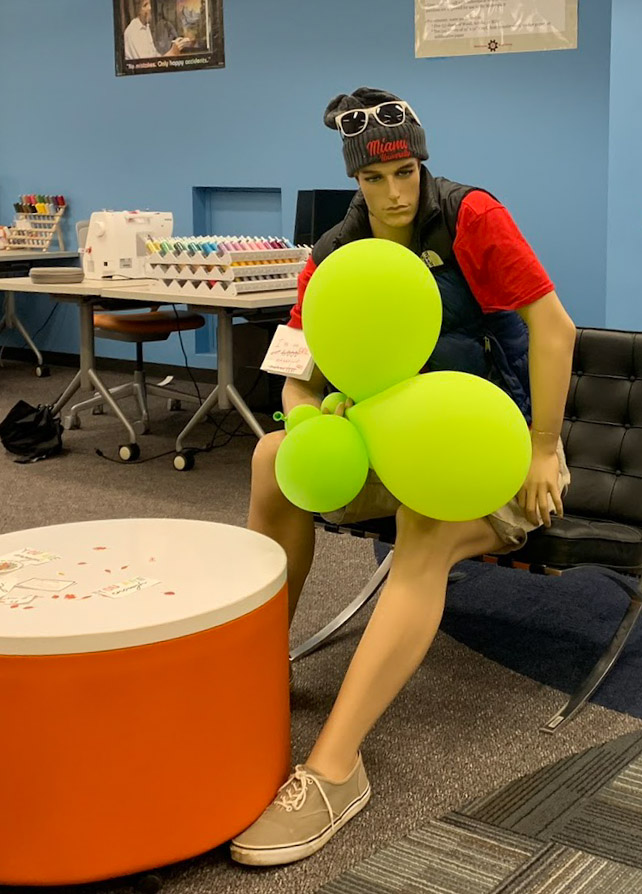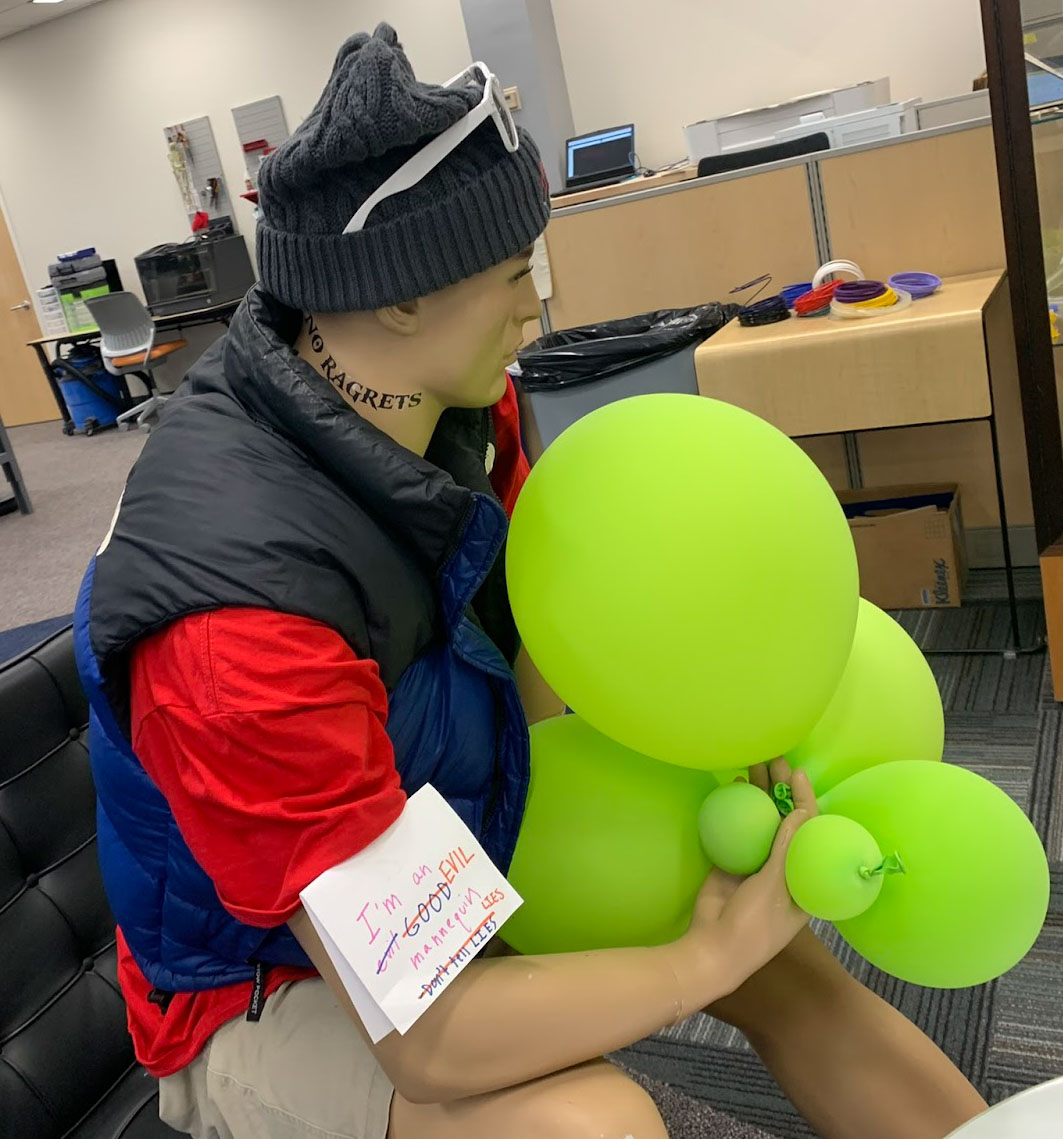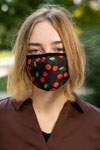
My name is Hal Howard, and I’m a third-year studying computer science at Miami University and working as an OhioLINK Luminary with the Miami University Libraries. I hope to pursue a career in library and information science. Within the series of articles, I detail my experiences and learning thus far while working with various departments and on various projects at the Miami University Libraries. Readers can look forward to learning about the process of creating metadata for a digital collection currently in progress, the experience of delving into web design for (almost and practically) the first time, the projects and potential of makerspaces and maker literacy, how to acclimate to the task flow of running statistics for about 5 hours on end within a month, and the considerations that go into course design. With this, I hope to effectively shed light in brief takeaways to interested faculty and students, informatively to the projects, and personally to the experiences of my involvement, learning, and contribution with them. Before delving in, I would like to emphasize that the learning in this program is rapid-fire. The Miami University Libraries are very effective in setting up ample opportunities to learn how their departments work as well as to contribute to the projects that these departments are responsible for, and they have many departments with many large, ongoing projects in each. As such, the learning curves associated are intense and frequent. To this day and as a relatively socially engaged student, I have never heard of a comparable experience, and as those in the College of Computing and Engineering know, computing and engineering students are all about experiential learning. Without further ado...
The digital Documenting the COVID-19 Pandemic collection holds a vast array of perspectives and experiences, in multiple formats, of students, faculty, staff, alumni, and even entire courses, pertaining to life during the COVID-19 pandemic and quarantine. In November of 2020, the libraries began accepting digital (and a few physical) submissions for the collection in development between Special Collections Librarian Rachel Makarowski and University Archivist Jacky Johnson. While working on the metadata for the collection, I was able to read up on experiences from within the community, some of which won’t be accessible to the public for up to or over the next century. I’ve definitely learned that there’s a challenge in knowing certain information and not being able to share it, such as funny or endearing scenarios that people got up to during that time and chose to document. I just know that when these pieces are available to the public, they will definitely be useful in establishing that people were people and they still found ways to get up to fun shenanigans during quarantine. An interesting and even intriguing note may be that the Extent of nearly all submissions was either under or around 10 pages (including those of honors students who wrote these for a grade), or above or around 70 pages, with far fewer submissions’ extent notably between. I do wonder if that’s a local case to the circumstances, environment, and time, or if this is part of a larger journalling pattern. Before metadata can be gathered, a metadata template must be built. I was not involved in the process of building the collection’s metadata template. Digital Collections Librarian Alia Wegner built a custom template for the collection, beginning from a standardized template. Standardized templates are used in order to establish semantic commonality so that metadata fields can be quickly understood between collections and even institutions. Once the digital collection’s template had been finalized, the metadata curation phase of the process began and has been ongoing ever since. This template includes the following fields, along with a few which are less relevant to those uninvolved with the collection’s maintenance: Title, Creator, Contributor, Publisher, Submitter, Date Created, Date Published, Date Submitted, Date Available, Place of Creation, Extent, Summary, Subjects (TGM), Local Subjects, Keywords, Genre (AAT), Language, Type, Permissions, Preservation File Name, and Metadata By.
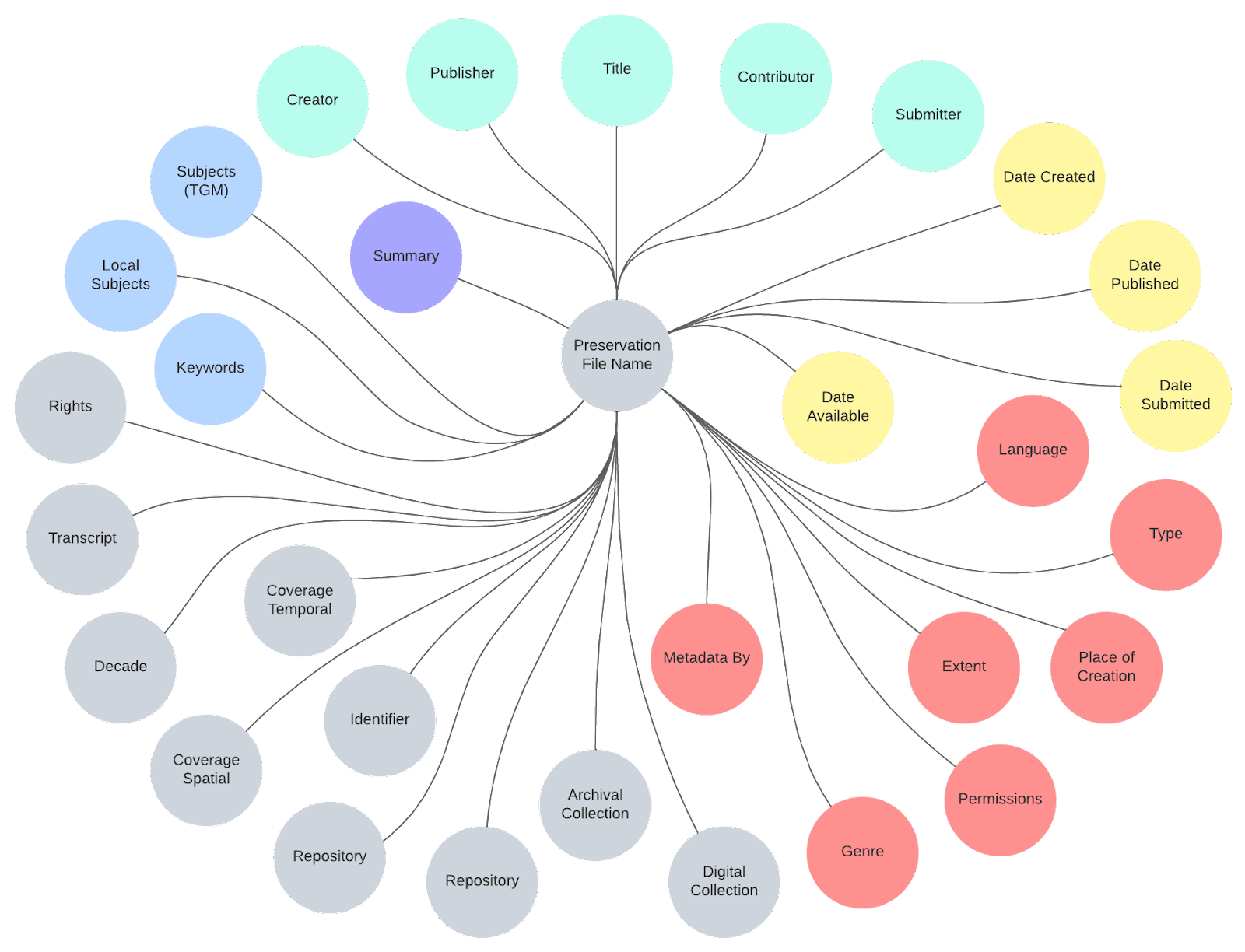
A few examples of some of these fields are displayed below.
Working with this collection was a fun experience. I definitely had to jump right into the deep end, with my prior understanding of metadata extending as far as social media’s usage of hashtagging, a few archival sites’ usage of fields, and a technical course in the underpinnings of how to develop and utilize databases. That is to say: my understanding of the purpose and requirements of metadata was barely functional. Thankfully, Preservation Librarian Kimberly Hoffman was able to help me get up to speed. Luckily for me, Special Collections keeps guides available for familiarizing with metadata, the process of generating helpful metadata, and the differences between various related metadata fields. A few good rules of thumb can be summarized as: “be formal, be informative, and don’t shy away from risqué keywords.” This is incredibly important as, if such terms, underage alcohol consumption in particular being one in the third category, remain non-denoted, researchers studying these subjects will not be able to utilize metadata to research efficiently. During this time, I was able to complete some training with the Preservica preservation suite, and learn about different storage techniques during times when I needed to briefly break my attention away from the collection in progress. I’m now learning the math behind how these considerations are taken into account from Dr. Karen Davis in one of my degree electives. Alongside such, I also learned a bit about how Miami University specifically chose their various storage services and utilities within a book that Hoffman suggested reading up on, Digital Preservation in Libraries: Preparing for a Sustainable Future by the Association for Library Collections and Technical Services (ALCTS). The metadata of collections is highly helpful in encouraging successful discovery and analysis. Miami University’s Student Health Center, known for spamming students with alcohol usage surveys, among much less easily filtered-away work such as the AlcoholEdu wellness module, may be interested in that particular keyword juxtaposed with the Local Subjects term “student life.” Looking into the subtle differences between fields, Submitter and Creator, for instance, define the significance of legal name versus preferred name to be referenced on-file. It should be noted that there is no way to verify that all of the content within submissions to this collection genuinely reflect a submitter’s experiences. A submitter under the age of twenty-one could be either truthful or dishonest about involvement in various organizations or even about drinking, for any reason, clout included. Subjects (TGM) denotes widely-accepted terms held by The Thesaurus for Graphic Materials, while Local Subjects refers to the university’s collection of terms, cross-collection, and Keywords speaks to terms strictly associated with a given collection. Date Published refers to the date within which a piece is published; if a piece is published first outside the collection, this will differ from Date Submitted. If a piece has Permissions status Embargoed, then that piece’s Date Available will differ from Date Submitted. If a piece is created on the same day as it is submitted, Date Created and Date Submitted will share the same date. It should be noted that submissions are still being accepted for this collection, and will continue to be accepted for the near and foreseeable future. I, myself, am planning on writing a reflection to submit, hopefully in the late summer academic term. If any student readers are interested in learning about and working with collections or metadata, I highly suggest sending an email to Library Associate Tiffany Dogan.
Before working with Systems and Web Services at the Miami University Libraries, my experience with web development was next to none. I’d a decade prior placed custom cursors on to web pages, explored a minuscule amount with CSS in setting up a splash page, used “website builders,” and that’s about it. My experience in a generalist “introduction to the various fields that you’ll be studying within your degree” course was negligible even compared to my early 2010s experience, with even divs unaccounted for. In order to maintain and share the anticipated 2022 exhibit’s digital resources, as well as to gather information on institutional interest, the college and libraries built a website that I was able to directly learn in the process of developing. I now find it hilarious that I ended up taking a web application development course directly after learning about web design, successfully able to bypass the “wait, what is a div?” wall that a few of my peers (who I definitely otherwise would have counted among) ran headfirst into. A “div” is a division or subdivision of another division of the page. I’m really not sure how I didn’t connect the dots sooner with the ingenious naming scheme employed. Thank you from the bottom of my heart, Ken Irwin, Jerry Yarnetsky, and Meng Qu, for your mentorship, incredibly effective teaching, generosity, and patience with my learning. The Finding Freedom Summer traveling exhibit is an initiative by the College of Creative Arts and the Miami University Libraries to educate fourth- and fifth-grade students about the Black Mississippian voter registration drive of 1964, wherein volunteers from the Western College for Women and Miami University of Oxford organized to assist. Three of these participants (James Chaney, Andrew Goodman, and Michael Schwerner) were murdered by the Ku Klux Klan and Mississippi local law enforcement.
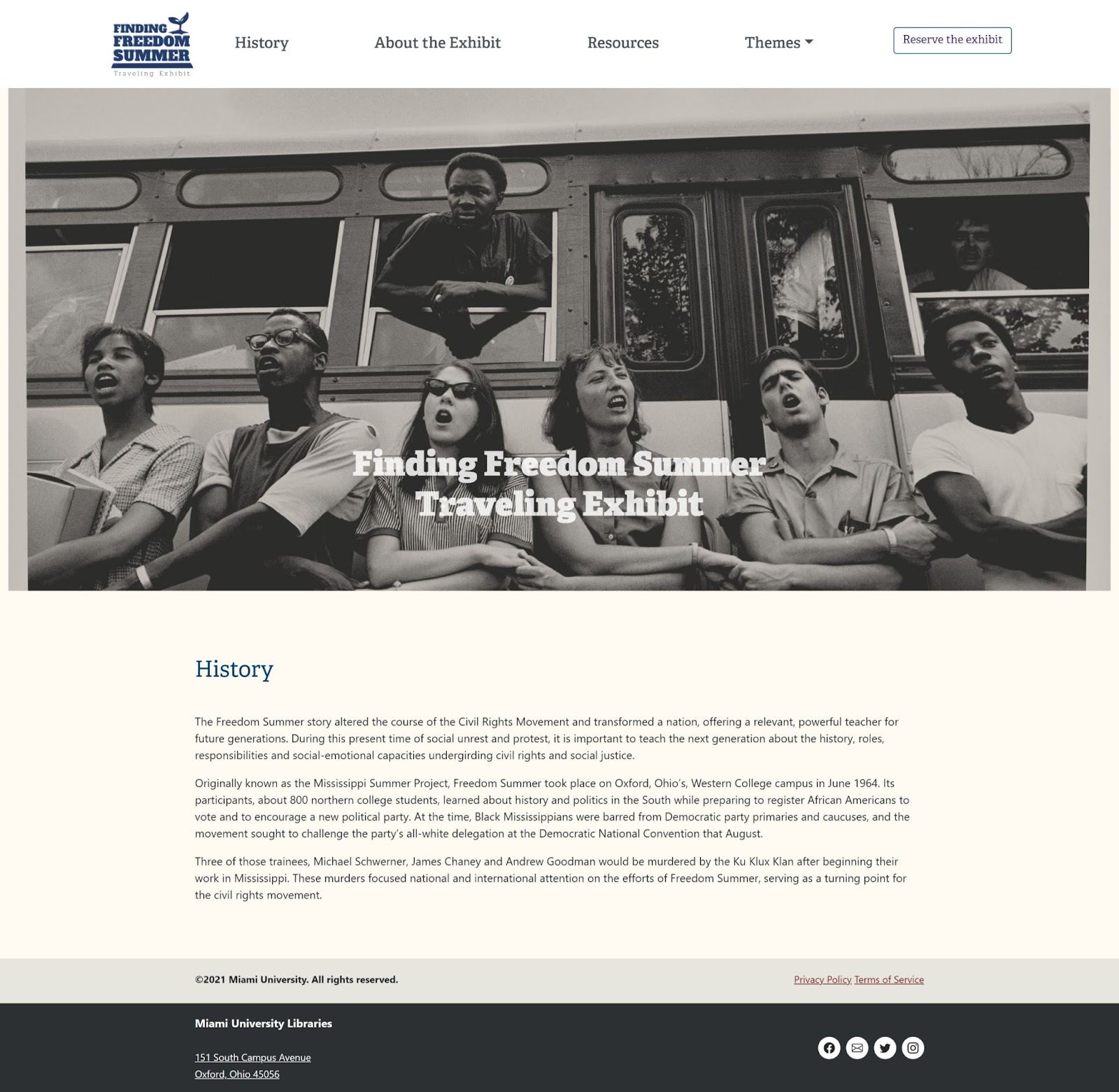
It was while encoding a potential Resources subpage and category implementation that I learned my most key development lesson yet, with this amazing group. Over the course of my degree, I’ve largely focused on building everything from absolute scratch. It’s really only as of now, in year three, that I’ve found myself working on designing automatic processes that do my work. To quote Ken Irwin, and I must say that this came across as a profound thought process at the time, which has also since led to an evaluation and series of massive alterations to how I approach my general use of the computer, “Make the computer do the work for you.” This was not my first time learning about Freedom Summer. It has been brought up as a topic within a few of my global and intercultural perspectives courses. This was, however, my first time working on any sort of project relating to it. I think that it is a very important event for people to learn about and come to understand, more than ever in the divisive times of today, and I’m grateful to have been able to help out with pulling the website for its exhibit together. The traveling exhibit’s website was not the only project that I worked on during this time; I also performed some requirements elicitation for software for the inclusive cataloging project; however, I do believe that professional development with MarcEdit, as referenced in my article on Technical Services, should be more convenient in ways that also benefit other ongoing projects.
Productivity of Technical Services
Analyzing statistics can be fun, because you never know if what you find is going to be the exact opposite of what you expect. Such was the case of the technical services office's productivity statistics, informally dubbed “The Results are Not as Hypothesized: An Analysis of the Miami University Libraries’ Technical Services Departmental Performance Pre-, During, and Post- Quarantine.” Initially, we had predicted that iii’s Sierra, the integrated library system utilized by academic libraries affiliated with OhioLINK, would reflect increasingly higher firm expenditure, particularly during the COVID-19 quarantine period. Leasing and maintenance costs would sharply rise. The Farmer School of Business or College of Computing and Engineering would pull the most from the library’s available funds. Firm expenditure, the amount that an institution expends in a fiscal year without considering incoming funds, would rise.
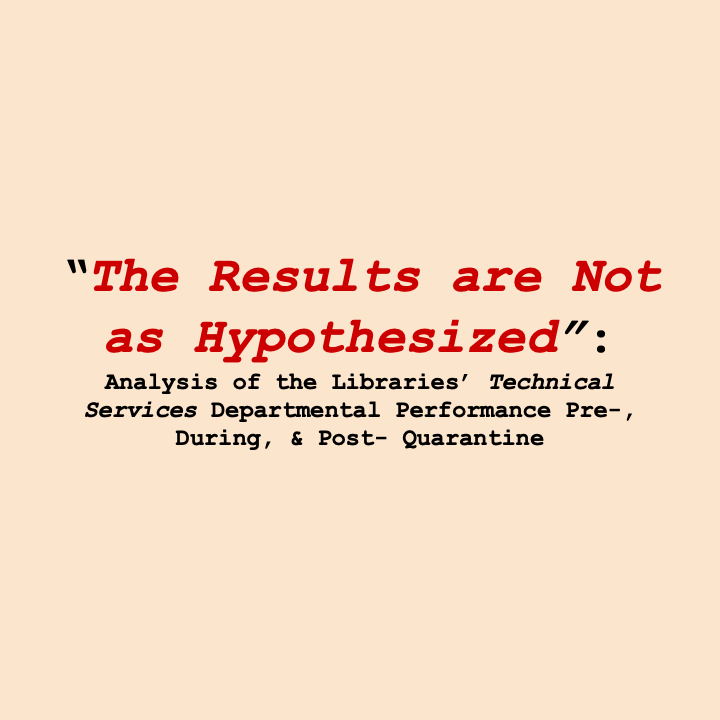
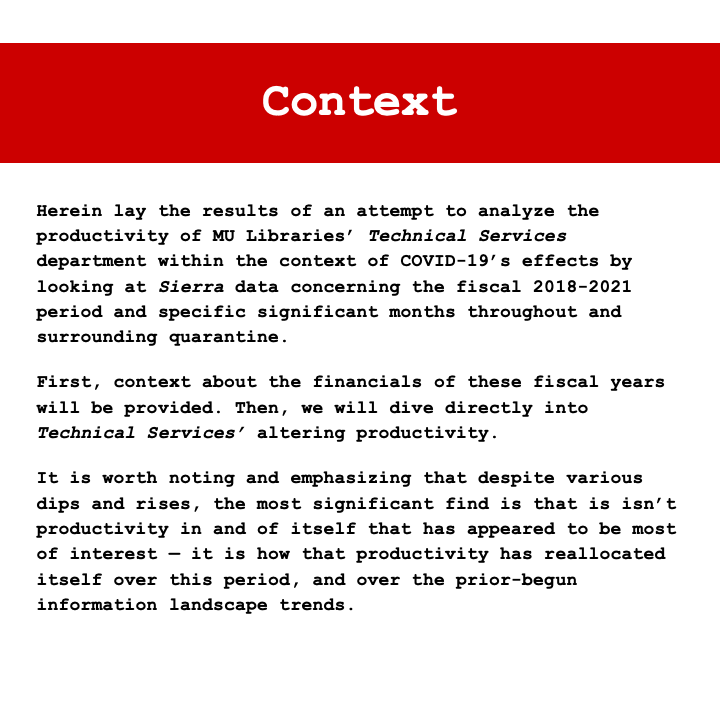

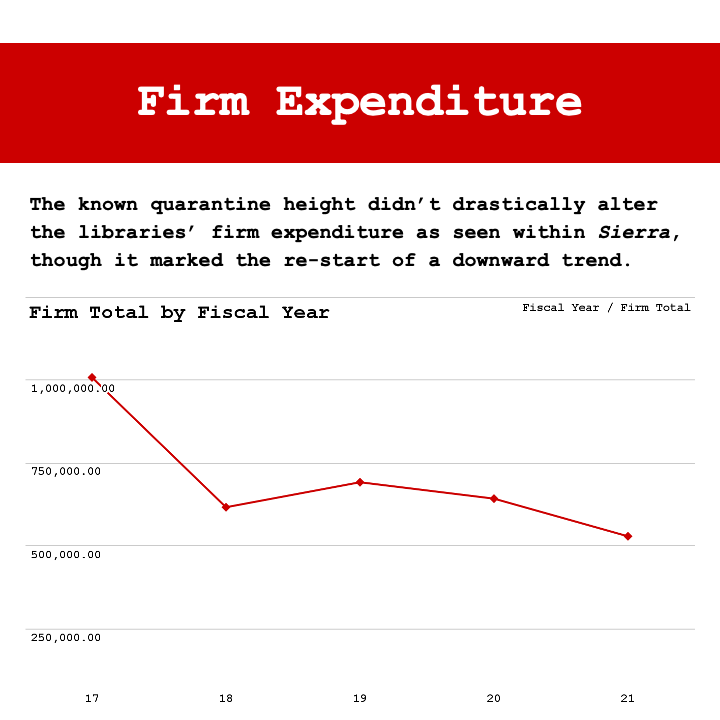
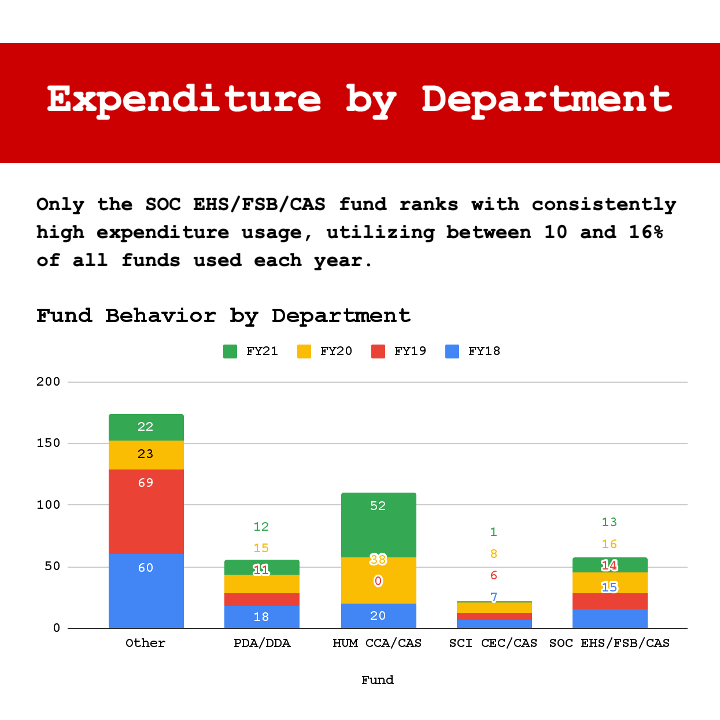
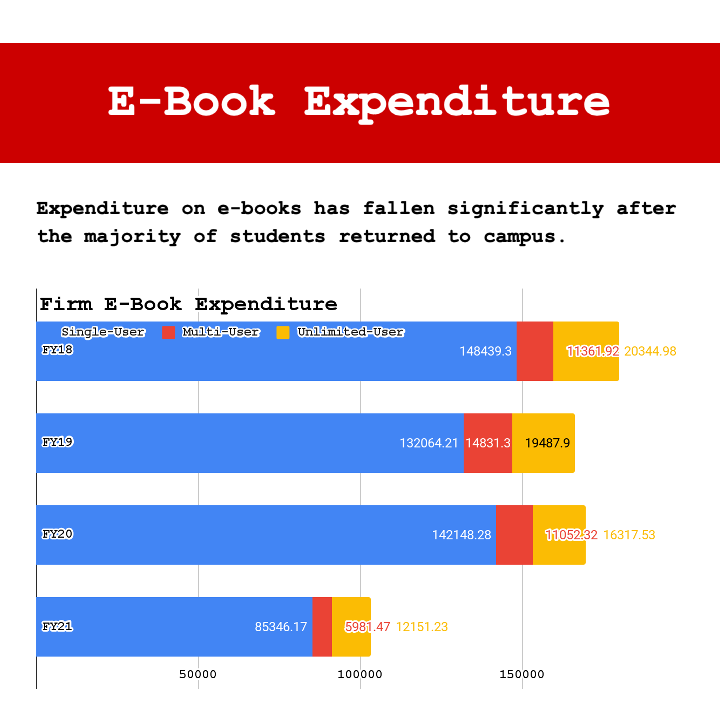
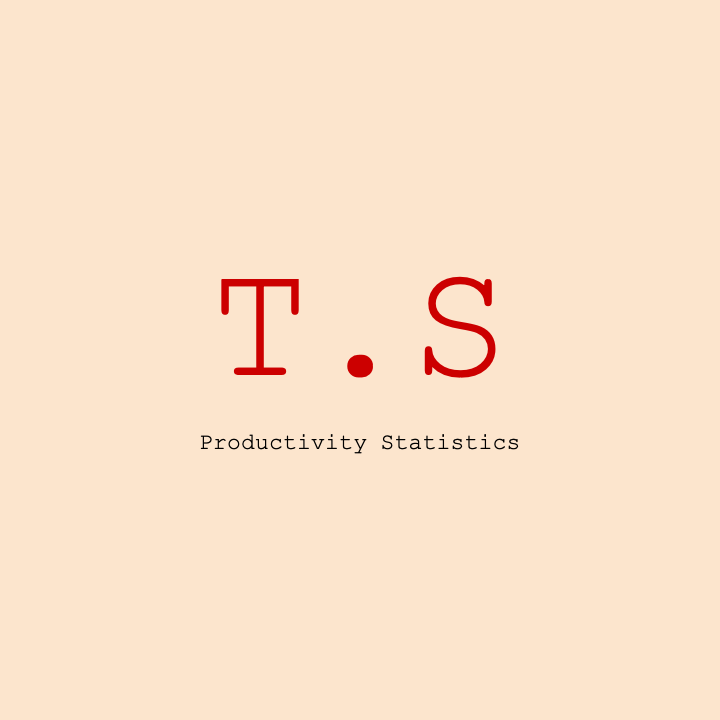
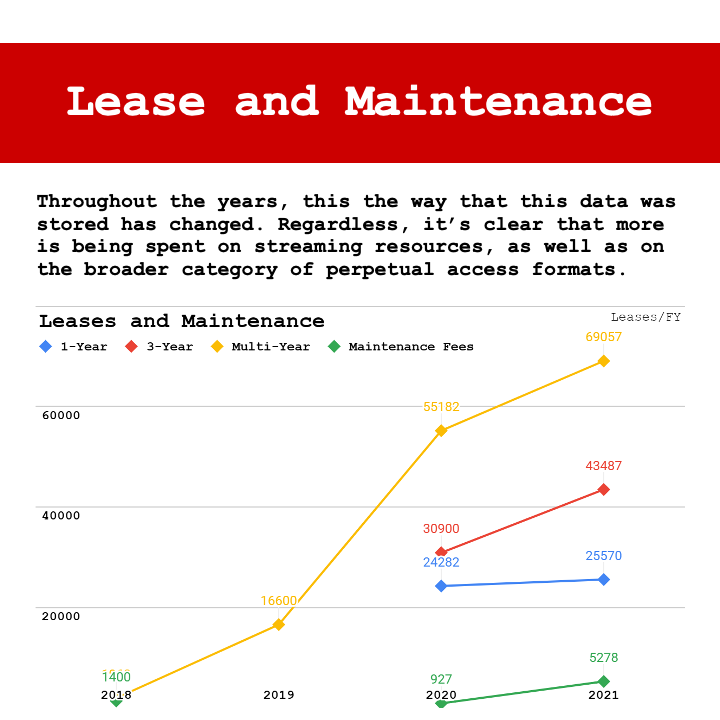
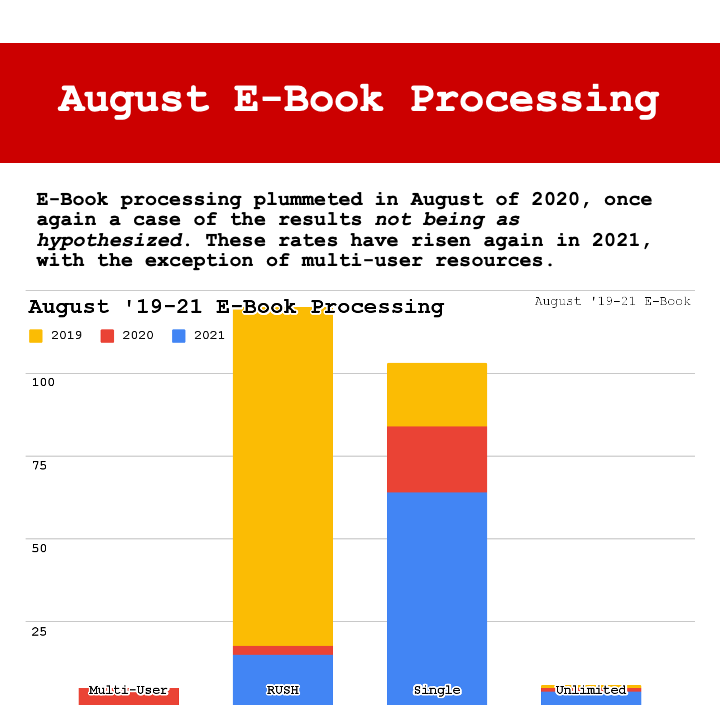
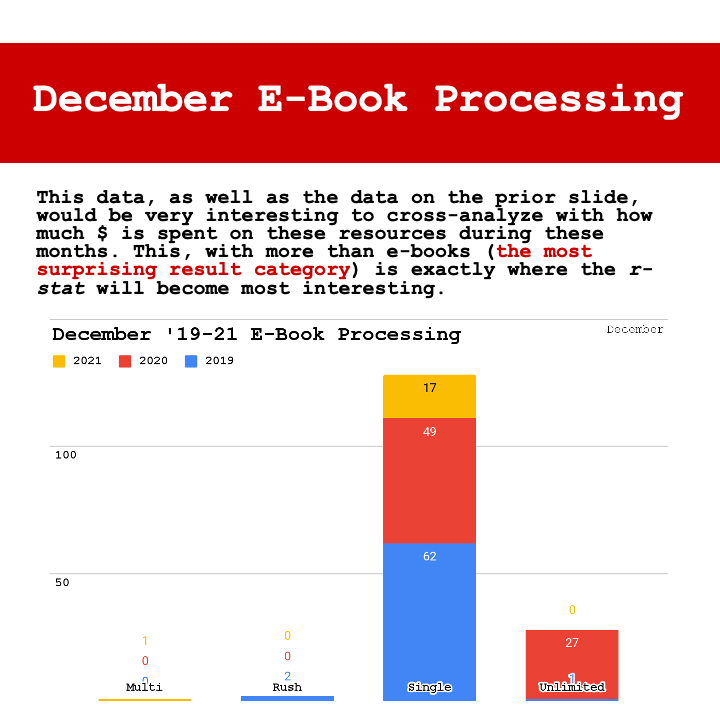
The only statement above not found to be false was the rise in leasing and maintenance costs. The College of Creative Arts and College of Arts and Sciences required almost double the funding of the Farmer School of Business. Total firm expenditure reflected within Sierra had already been on a downward trend, only broken by a slight increase in 2019. Even after students left campus, firm ebook expenditure in 2020 never rose to the high of 2018, and fell drastically in 2021. It’s almost worth wondering if students were tired of looking at their screens after quarantine. I do know that I definitely was and am. While I would have loved to analyze these statistics more in-depth, I did run into complex delimitation issues during this departmental rotation. For all of my statistics studying during my degree, it’s surprising how little time is spent learning that first step of how to clean data. Throughout my time at the Miami University Libraries, I had heard many times about iii’s Sierra. It was only when working with Technical Services that I finally understood all that I had been hearing. Now, there is actually a program that is already in use for some tasks at the Miami University Libraries that I do believe could have majorly helped out with that dilemma, but also has the potential to be of use in the inclusive cataloging project under the direction of Coordinator of Cataloging and Slavic Librarian, Masha Stepanova. The Miami University Libraries should allot time for some of its librarians to delve deeper into learning Terry Reese’s MarcEdit. Thinking further ahead even, if OhioLINK is truly more strongly than ever considering switching away from Sierra, this would be a great solution to other ongoing, time-consuming, ever-unending projects such as fixing outdated codes within the catalogs. It may also be of use to consider a few relational calculus practice sessions within professional development efforts, alongside time spent familiarizing with MarcEdit; familiarity with relational calculus concepts would enable strategic rephrasing of queries for high speed and efficiency in any catalog update-associated projects, while MarcEdit would provide a direct interface for task flows that Sierra handles less conveniently. Many task flows of these types that are currently a major point of stress, time, and monotonous screen-staring could be automated (with results still validated after for quality assurance, of course), saving Stepanova and other librarians quite a lot of time and energy. As our friends in the business school and specifically software engineering often remind us, increases in time and energy lead to increases in student resources, innovation, and funding.
There’s a lot more that goes on under the hood of literacy than many might initially suspect. Under Jaclyn Spraetz and Nathaniel Floyd in the Miami University Libraries’ Advise & Instruct department, I was able to participate in and contribute to the design of a new, one-credit hour course within the IMS/ETBD department: IMS 202, Information Studies and Digital Citizenship. This course allows students to engage by learning information literacy in practice and explores contemporary developments in information literacy, policy, and ethics in a variety of digital dimensions, with weekly hands-on activities and discussions. During coffee hours in prior departments, I’d heard about different academic librarians’ unique struggles with attempting to teach information literacy concepts within short periods of time allotted to specific classes; this course isn’t designed to entirely alleviate that problem, but it is intended to teach students how to perform research effectively both for their academic studies and in their day-to-day lives. Now, it’s also worth pointing out that there’s a very different type of information literacy that tends to be forgotten: maker literacy. There’s a thought today that one isn’t truly learning unless they’re doing. I actually think that learning does contain studying, but the other pieces of the equation, confidence and real-time effect, do indeed come with doing.
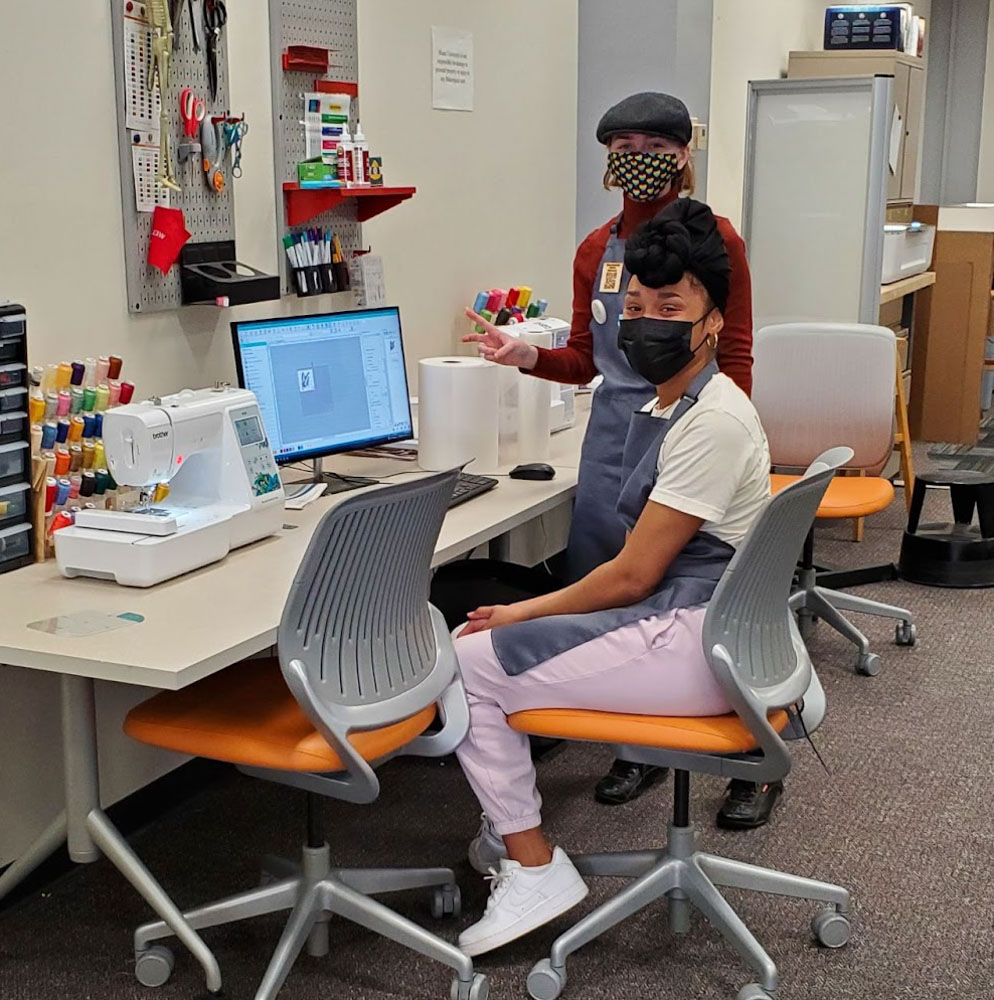
Sarah Nagle, Creation and Innovation Services Librarian at the Miami University Libraries, has a wonderful article Metaliteracy and Maker Literacy which discusses in much further detail what maker literacy is and how to develop it. Maker literacy is quite different from information literacy, but its outcomes are quite similar to those of metaliteracy. The two share such ideas as the gaining of skills, cognitive mapping of the given domain(s), attitude towards doing, and self-understanding of one’s learning. In extremely simplified terms, information literacy specifies an understanding of domain, metaliteracy describes an understanding of design, and maker literacy describes a capability to enact; these three overlap significantly into one another. Libraries exist to provide resources and act as launchpads for different communities and institutions in society. Academic libraries typically are thought of as research launchpads; medical libraries and law libraries are field-specific; public libraries provide resources for the general population and often conduct community outreach programing. The makerspace uniquely serves as a project-based launchpad. Keisha Norris, CEC Departmental Advisor at Miami University, also has some ideas on this subject, particularly as the CEC department only just introduced for this upcoming Fall 2022 semester a new course for first-year undergraduate students, CEC 111, Imagination Ingenuity Impact I (or, in lay terms, an introduction to project-based innovation in engineering). This is a pilot project, and is to begin in the Fall of 2022. Within the department, it’s uncommon for first-year undergraduates to begin working with hands-on projects right away; this (hopefully two-part) course aims to connect students and allow them to start building confidence in their making skills and engineering-specific maker literacy as soon as they begin their degree. Norris is currently looking for more undergraduate assistants to join in on this effort; if any upperclass CEC students are interested, they should apply. There are particular courses within the CSE department wherein particular facets of metaliteracy do stick out. As a CSE student, I don’t have enough experience with CEC classes to provide further commentary on their courses. However, in such courses as Software Engineering for UI/UX Design, the civic mindedness tendency of metaliterate learners is built through consideration for user perspectives and accessibility. If there is one thing that these departments, both within the library and within the colleges, can agree on, it is that literacy increases autonomy. This is true for information literacy, metaliteracy, and maker literacy. It is worth mentioning as well that, for one to gain autonomy within a space, they must first be able to access it. The Libraries do a good job of keeping their makerspace physically accessible. With plenty of room for navigation throughout the various areas of the space, there’s plenty of room for everyone. Standing and sitting-height tables adorn the space, with many of both chairs that move and chairs that are still.
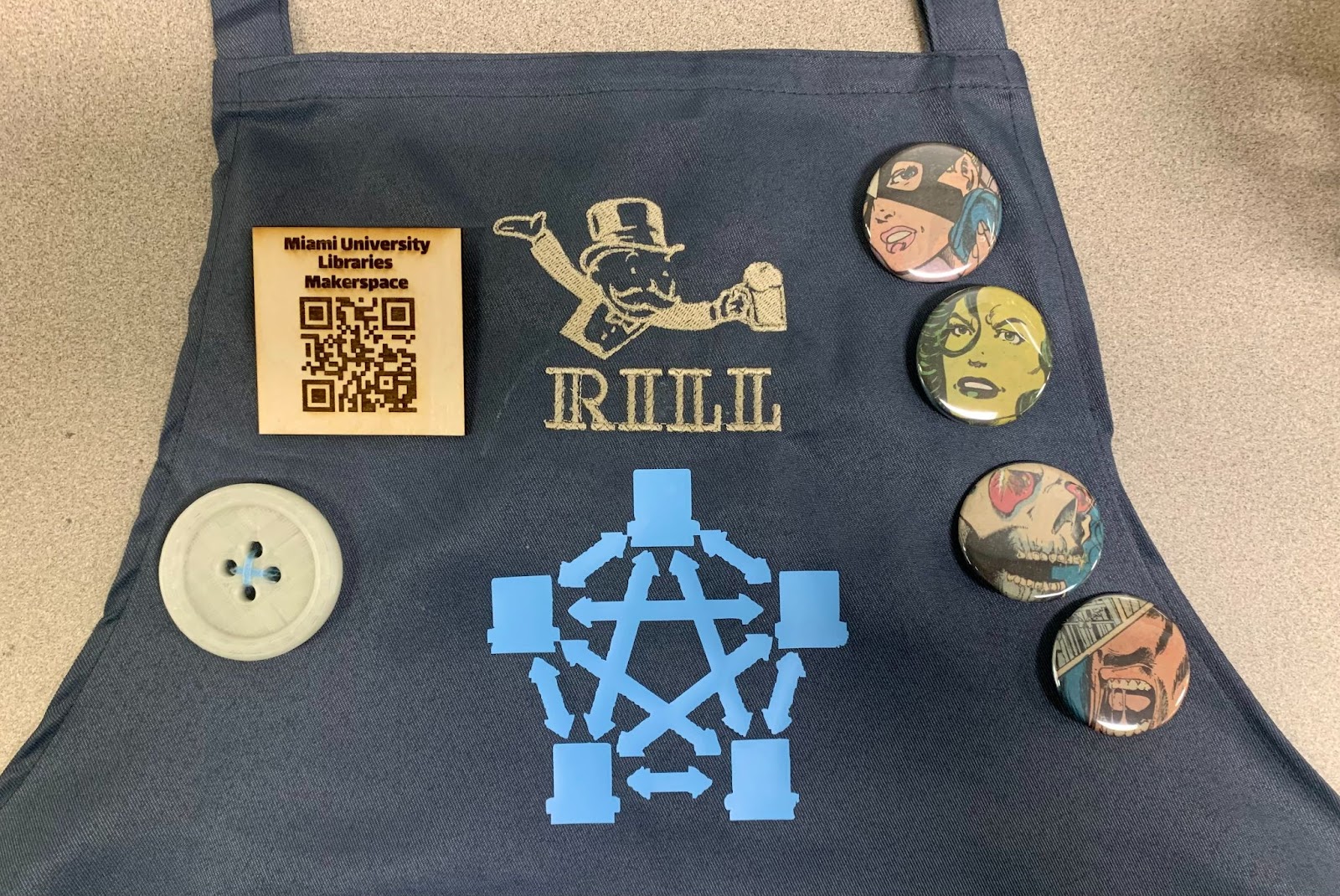
While working with Create and Innovate earlier this semester, I was able to pull together a bit of a student apron (my designs are much less complex than my fellow Luminary, Ashley Sankey’s – I was too eager to learn a little bit of everything as opposed to the intensive, impressive deep-diving that hers displays). Student employees of the Makerspace all design these, adding items to them as they gain experience and competency with the various machines that the Makerspace offers usage of to the university’s students. Above, you can see that I learned button-making, as well as the fundamentals of the Glowforge (laser-cutting), how to use the embroidery machine, 3D printing, and more. There are a few specific design choices that I made with the apron to note which tie into this discussion, however. Makerspaces, being community-oriented prototyping, crafting, repairing, and building spaces, are intrinsically tied to an idea in emerging technologies referred to as open-source. On the apron above, there is a light blue outline of a peer-to-peer network. This is not a reference to crypto-mining, for anyone who got excited at the mention of p2p. Neither is the monopoly man a declaration of support for monopolies. Much of maker philosophy can be found in open-source communities and peer-to-peer networking enthusiasts. It is becoming more common than ever, now, to hear user complaints of the hindrances of web developments associated with Web 2.0. While UX researchers and designers are often left with the question of how much user autonomy is helpful versus distracting in task efficiency or at odds with increasing business metrics, both makerspaces and these niche software maker communities online find themselves with similar foreboding questions (including in the internet communities’ fun and often highly-differing “internet manifestos”), accessibility concerns being one of them. Just recently, the Makerspace got a rearrangement, with 3D printers moved to the back and a wire cover placed over the (very thick, with safety taken into consideration) only wire that I know, at least, to openly cross the floor. Just as before, there is plenty of room for maneuverability within the makerspace, with accessibility taking high focus in its reorganization. In addition, on behalf of the makerspace student employees, I would like to introduce everyone to Guillermo. To anyone who likes to sit outside the Makerspace after-hours that may be reading this, we do promise that he neither bites nor comes to life to cause mayhem. He just stares.
